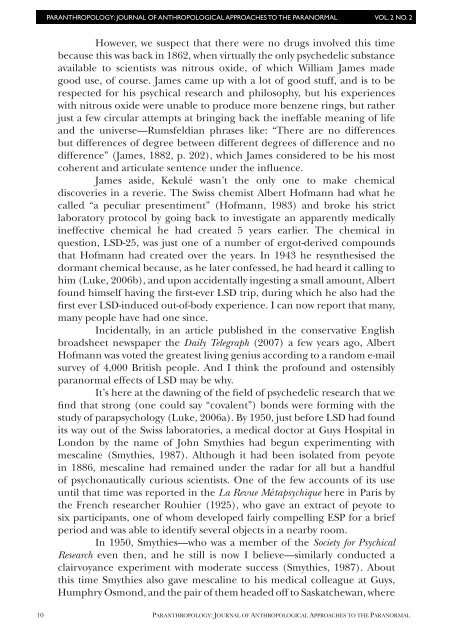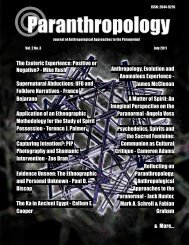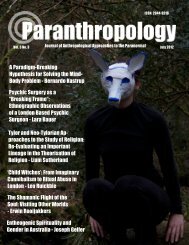Psi and Psychedelics - Paranthropology - Weebly
Psi and Psychedelics - Paranthropology - Weebly
Psi and Psychedelics - Paranthropology - Weebly
Create successful ePaper yourself
Turn your PDF publications into a flip-book with our unique Google optimized e-Paper software.
224 The Journal of Parapsychology<br />
PARANTHROPOLOGY: JOURNAL OF ANTHROPOLOGICAL APPROACHES TO THE PARANORMAL VOL. 2 NO. 2<br />
However, we suspect that there were no drugs involved this time<br />
because this was back in 1862, when virtually the only psychedelic substance<br />
available to scientists was nitrous oxide, of which William James made<br />
good use, of course. James came up with a lot of good stuff, <strong>and</strong> is to be<br />
respected for his psychical research <strong>and</strong> philosophy, but his experiences<br />
with nitrous oxide were unable to produce more benzene rings, but rather<br />
just a few circular attempts at bringing back the ineffable meaning of life<br />
<strong>and</strong> the universe—Rumsfeldian phrases like: “There are no differences<br />
but differences of degree between different degrees of difference <strong>and</strong> no<br />
difference” (James, 1882, p. 202), which James considered to be his most<br />
coherent <strong>and</strong> articulate sentence under the influence.<br />
James aside, Kekulé wasn’t the only one to make chemical<br />
discoveries in a reverie. The Swiss chemist Albert Hofmann had what he<br />
called “a peculiar presentiment” (Hofmann, 1983) <strong>and</strong> broke his strict<br />
laboratory protocol by going back to investigate an apparently medically<br />
ineffective chemical he had created 5 years earlier. The chemical in<br />
question, LSD-25, was just one of a number of ergot-derived compounds<br />
that Hofmann had created over the years. In 1943 he resynthesised the<br />
dormant chemical because, as he later confessed, he had heard it calling to<br />
him (Luke, 2006b), <strong>and</strong> upon accidentally ingesting a small amount, Albert<br />
found himself having the first-ever LSD trip, during which he also had the<br />
first ever LSD-induced out-of-body experience. I can now report that many,<br />
many people have had one since.<br />
Incidentally, in an article published in the conservative English<br />
broadsheet newspaper the Daily Telegraph (2007) a few years ago, Albert<br />
Hofmann was voted the greatest living genius according to a r<strong>and</strong>om e-mail<br />
survey of 4,000 British people. And I think the profound <strong>and</strong> ostensibly<br />
paranormal effects of LSD may be why.<br />
It’s here at the dawning of the field of psychedelic research that we<br />
find that strong (one could say “covalent”) bonds were forming with the<br />
study of parapsychology (Luke, 2006a). By 1950, just before LSD had found<br />
its way out of the Swiss laboratories, a medical doctor at Guys Hospital in<br />
London by the name of John Smythies had begun experimenting with<br />
mescaline (Smythies, 1987). Although it had been isolated from peyote<br />
in 1886, mescaline had remained under the radar for all but a h<strong>and</strong>ful<br />
of psychonautically curious scientists. One of the few accounts of its use<br />
until that time was reported in the La Revue Métapsychique here in Paris by<br />
the French researcher Rouhier (1925), who gave an extract of peyote to<br />
six participants, one of whom developed fairly compelling ESP for a brief<br />
period <strong>and</strong> was able to identify several objects in a nearby room.<br />
In 1950, Smythies—who was a member of the Society for Psychical<br />
Research even then, <strong>and</strong> he still is now I believe—similarly conducted a<br />
clairvoyance experiment with moderate success (Smythies, 1987). About<br />
this time Smythies also gave mescaline to his medical colleague at Guys,<br />
Humphry Osmond, <strong>and</strong> the pair of them headed off to Saskatchewan, where<br />
10 PARANTHROPOLOGY: JOURNAL OF ANTHROPOLOGICAL APPROACHES TO THE PARANORMAL




